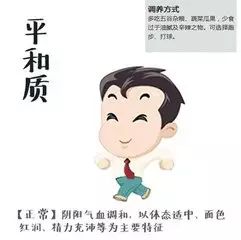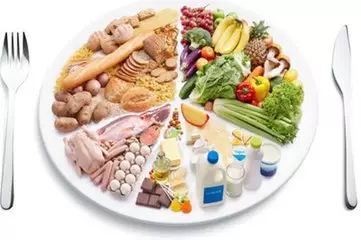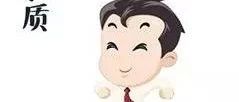
The state of constitution characterized by a balance of Qi (vital energy), blood, Yin, and Yang, with no adverse symptoms.
Constitution Characteristics Physical Characteristics: Well-proportioned, neither overweight nor underweight. Psychological Characteristics: Calm demeanor, easy-going personality, lively and cheerful. Overall Symptoms: The main features include a well-proportioned body shape, rosy and radiant complexion, and abundant energy, reflecting the harmony of Yin, Yang, Qi, and blood. Common Manifestations: Rosy complexion and skin, thick and shiny hair, bright and spirited eyes, moist and clear nose, normal sense of smell and taste, rosy lips, abundant energy, tolerance to cold and heat, good sleep, normal bowel movements, pale red tongue, thin white coating, and a soft, strong pulse are the main manifestations. Adaptability: Strong ability to adapt to external conditions. Tendency to Illness: Rarely falls ill. TCM Nurturing 1 Emotional Regulation Individuals with a harmonious constitution have an easy-going and cheerful personality, good psychological quality, and should often communicate with friends, cultivate hobbies beneficial to body and mind, be kind to others, help others, avoid comparisons and grudges, which helps maintain a peaceful mental state and establish good interpersonal relationships. 2 Dietary Regulation The diet should be rich in nutrition, with a reasonable balance of meat and vegetables, avoiding picky eating. Eating should be moderate, avoiding excessive hunger or fullness, and not overly cold or hot foods. Minimize oil and salt intake.
Physical Characteristics: Well-proportioned, neither overweight nor underweight. Psychological Characteristics: Calm demeanor, easy-going personality, lively and cheerful. Overall Symptoms: The main features include a well-proportioned body shape, rosy and radiant complexion, and abundant energy, reflecting the harmony of Yin, Yang, Qi, and blood. Common Manifestations: Rosy complexion and skin, thick and shiny hair, bright and spirited eyes, moist and clear nose, normal sense of smell and taste, rosy lips, abundant energy, tolerance to cold and heat, good sleep, normal bowel movements, pale red tongue, thin white coating, and a soft, strong pulse are the main manifestations. Adaptability: Strong ability to adapt to external conditions. Tendency to Illness: Rarely falls ill. TCM Nurturing 1 Emotional Regulation Individuals with a harmonious constitution have an easy-going and cheerful personality, good psychological quality, and should often communicate with friends, cultivate hobbies beneficial to body and mind, be kind to others, help others, avoid comparisons and grudges, which helps maintain a peaceful mental state and establish good interpersonal relationships. 2 Dietary Regulation The diet should be rich in nutrition, with a reasonable balance of meat and vegetables, avoiding picky eating. Eating should be moderate, avoiding excessive hunger or fullness, and not overly cold or hot foods. Minimize oil and salt intake.  3 Daily Routine Adjustment Daily life should align with the seasonal climate characteristics, ensuring adequate sleep. In spring, go to bed early and rise early; in summer, sleep late and rise early, with appropriate naps; in autumn, go to bed early and rise early; in winter, go to bed early and rise late. Adjust clothing according to climate changes. Sleep and rest should follow the four seasons: health maintenance should adjust according to the Yin and Yang changes of the four seasons, following natural laws to receive nourishment from heaven and earth. The human biological clock aligns with the natural rhythms of the four seasons and day and night, and arranging daily activities according to these natural laws is beneficial for health. The four seasons have characteristics of spring warmth, summer heat, autumn coolness, and winter cold, and living organisms correspondingly exhibit changes of spring growth, summer flourishing, autumn harvest, and winter storage. The timing of daily activities should vary according to the different Yin and Yang relationships of the seasons; “Nurturing Yang in Spring and Summer” suggests going to bed early and rising early in spring, and sleeping late and rising early in summer, with appropriate naps due to longer days; “Nurturing Yin in Autumn and Winter” suggests going to bed early and rising early in autumn, and going to bed early and rising late in winter. 4 Exercise and Physical Activity Depending on personal physical strength, engage in gentle exercises such as Tai Chi (Taijiquan), Five Animal Frolics (Wu Qin Xi), Eight Pieces of Brocade (Ba Duan Jin), or walking. More vigorous activities such as running, basketball, volleyball, soccer, kicking shuttlecock, dancing, aerobics, or playing diabolo can also be chosen. Long-term adherence to physical exercise can regulate Qi, enhance constitution, and promote emotional well-being. Individuals with a harmonious constitution have abundant energy and good physical strength, and can engage in both gentle exercises like Tai Chi (Taijiquan), Five Animal Frolics (Wu Qin Xi), Eight Pieces of Brocade (Ba Duan Jin), or walking, as well as more vigorous activities based on personal strength and preferences. 5 Meridian Regulation Regularly press and massage acupoints such as Zusanli (ST36) and Yongquan (KD1) for health benefits. Zusanli (ST36) is located four fingerbreadths below the outer knee and one fingerbreadth lateral to the tibia. This acupoint is a key health point because the spleen and stomach are the foundation of postnatal life. Regular massage of Zusanli can regulate the body’s immunity, enhance disease resistance, tonify the spleen and stomach, boost Qi, promote circulation, dispel wind and dampness, and strengthen the body’s defenses. Yongquan (KD1) is located at the depression on the sole of the foot, one-third of the distance from the toes to the heel along the line connecting the tips of the second and third toes to the heel. “The kidney emerges from Yongquan, which is the heart of the foot.” The kidney is the source of congenital essence; regular massage of this point can ensure sufficient kidney essence, enhance hearing and vision, and provide abundant energy for walking with strength.
3 Daily Routine Adjustment Daily life should align with the seasonal climate characteristics, ensuring adequate sleep. In spring, go to bed early and rise early; in summer, sleep late and rise early, with appropriate naps; in autumn, go to bed early and rise early; in winter, go to bed early and rise late. Adjust clothing according to climate changes. Sleep and rest should follow the four seasons: health maintenance should adjust according to the Yin and Yang changes of the four seasons, following natural laws to receive nourishment from heaven and earth. The human biological clock aligns with the natural rhythms of the four seasons and day and night, and arranging daily activities according to these natural laws is beneficial for health. The four seasons have characteristics of spring warmth, summer heat, autumn coolness, and winter cold, and living organisms correspondingly exhibit changes of spring growth, summer flourishing, autumn harvest, and winter storage. The timing of daily activities should vary according to the different Yin and Yang relationships of the seasons; “Nurturing Yang in Spring and Summer” suggests going to bed early and rising early in spring, and sleeping late and rising early in summer, with appropriate naps due to longer days; “Nurturing Yin in Autumn and Winter” suggests going to bed early and rising early in autumn, and going to bed early and rising late in winter. 4 Exercise and Physical Activity Depending on personal physical strength, engage in gentle exercises such as Tai Chi (Taijiquan), Five Animal Frolics (Wu Qin Xi), Eight Pieces of Brocade (Ba Duan Jin), or walking. More vigorous activities such as running, basketball, volleyball, soccer, kicking shuttlecock, dancing, aerobics, or playing diabolo can also be chosen. Long-term adherence to physical exercise can regulate Qi, enhance constitution, and promote emotional well-being. Individuals with a harmonious constitution have abundant energy and good physical strength, and can engage in both gentle exercises like Tai Chi (Taijiquan), Five Animal Frolics (Wu Qin Xi), Eight Pieces of Brocade (Ba Duan Jin), or walking, as well as more vigorous activities based on personal strength and preferences. 5 Meridian Regulation Regularly press and massage acupoints such as Zusanli (ST36) and Yongquan (KD1) for health benefits. Zusanli (ST36) is located four fingerbreadths below the outer knee and one fingerbreadth lateral to the tibia. This acupoint is a key health point because the spleen and stomach are the foundation of postnatal life. Regular massage of Zusanli can regulate the body’s immunity, enhance disease resistance, tonify the spleen and stomach, boost Qi, promote circulation, dispel wind and dampness, and strengthen the body’s defenses. Yongquan (KD1) is located at the depression on the sole of the foot, one-third of the distance from the toes to the heel along the line connecting the tips of the second and third toes to the heel. “The kidney emerges from Yongquan, which is the heart of the foot.” The kidney is the source of congenital essence; regular massage of this point can ensure sufficient kidney essence, enhance hearing and vision, and provide abundant energy for walking with strength.


